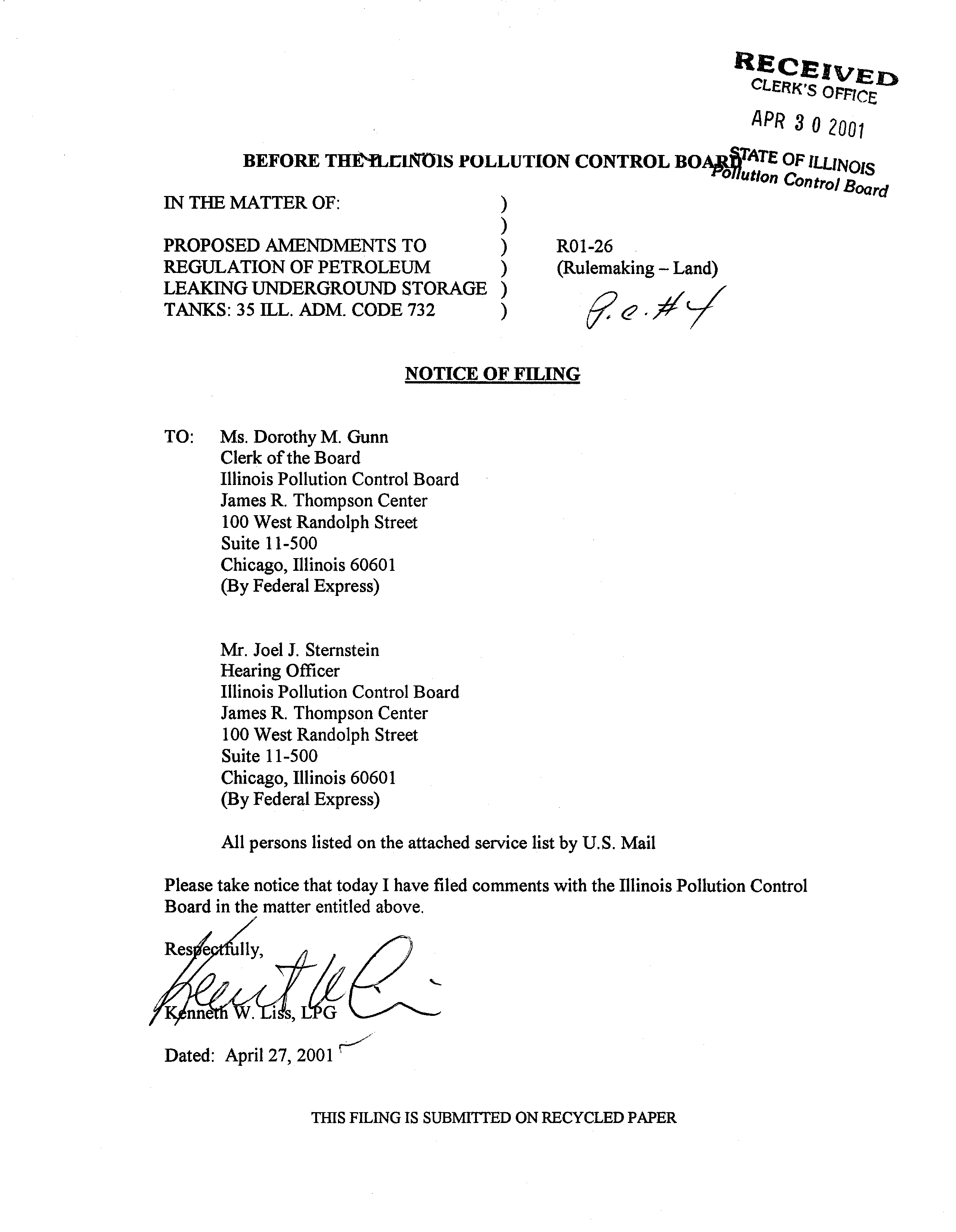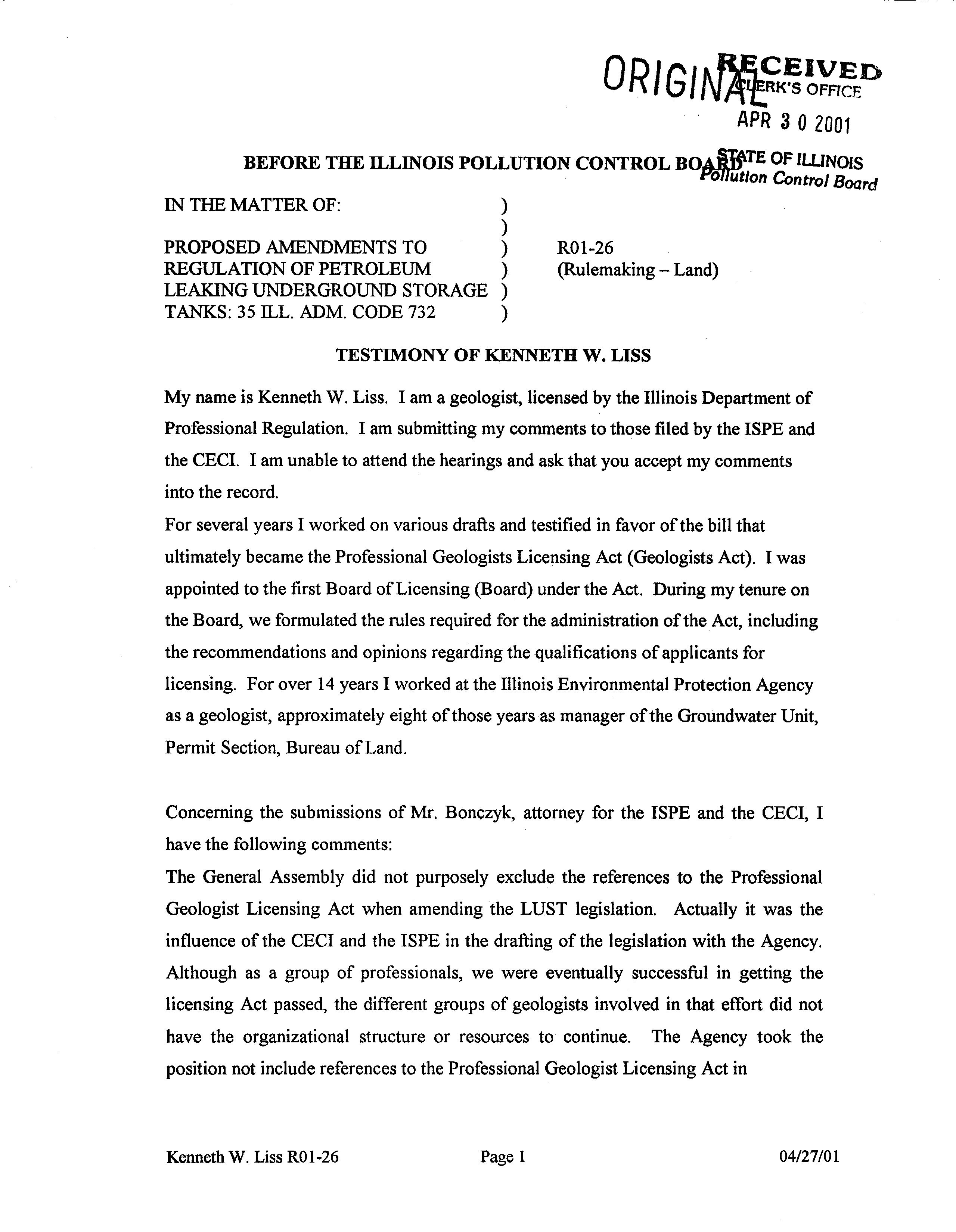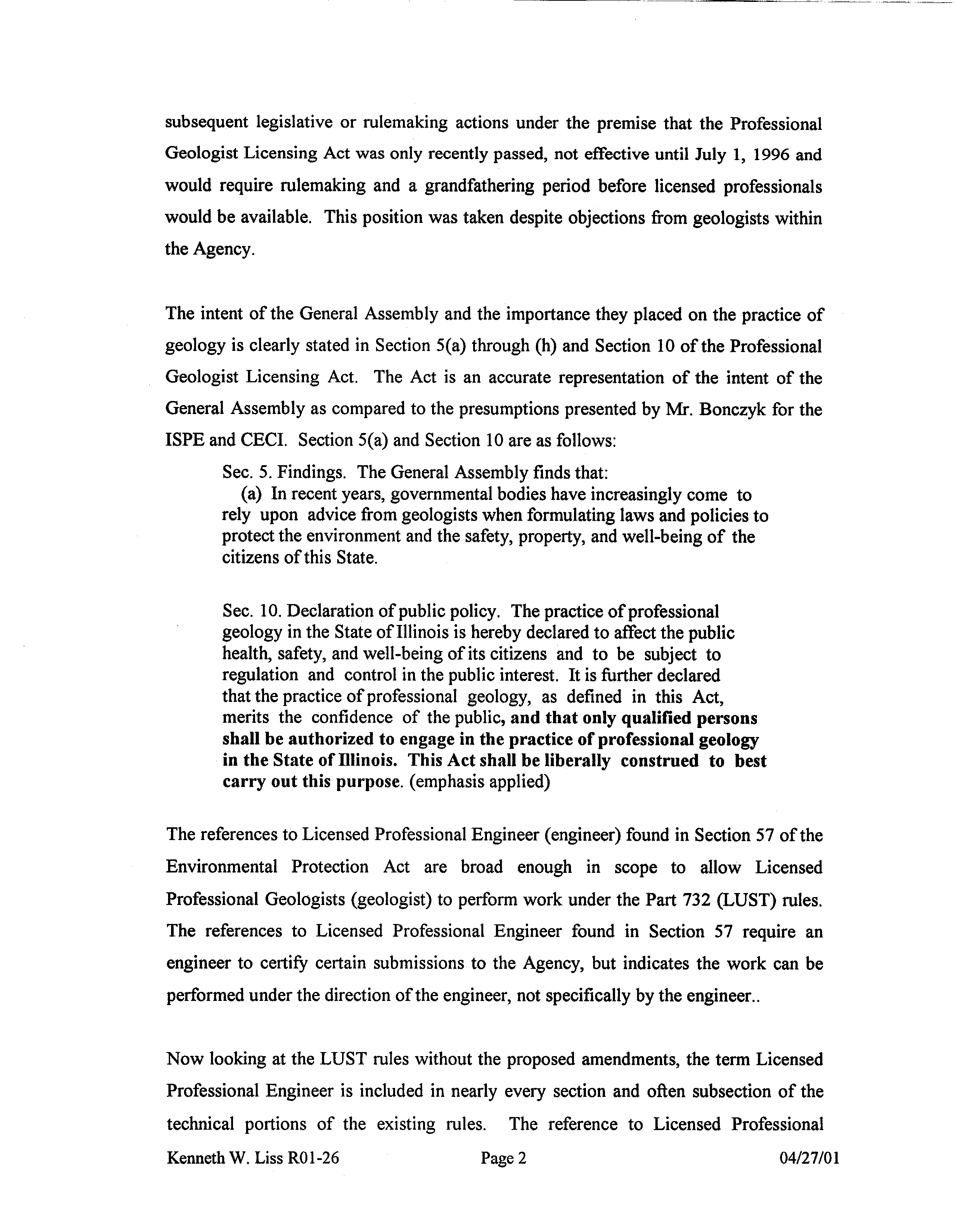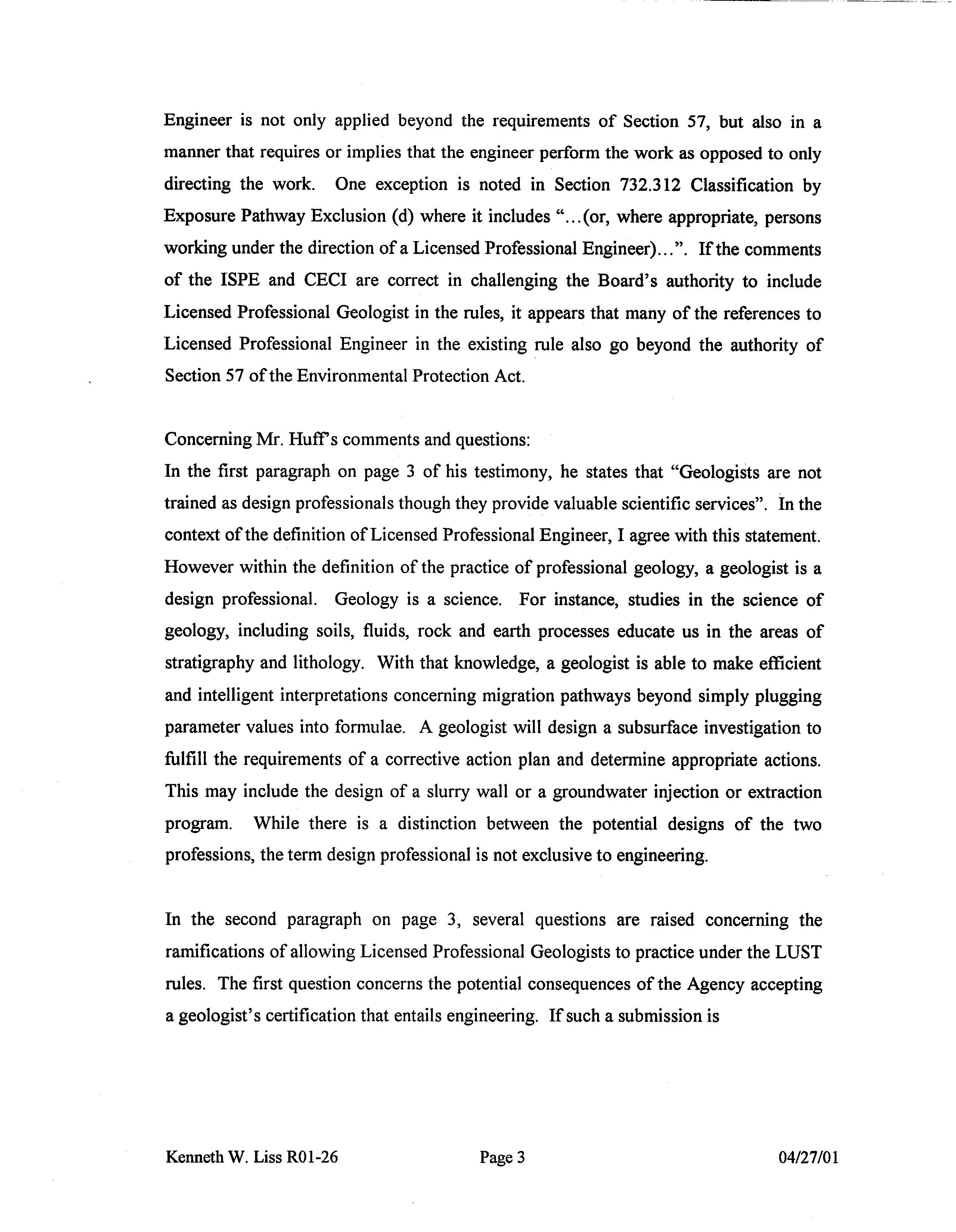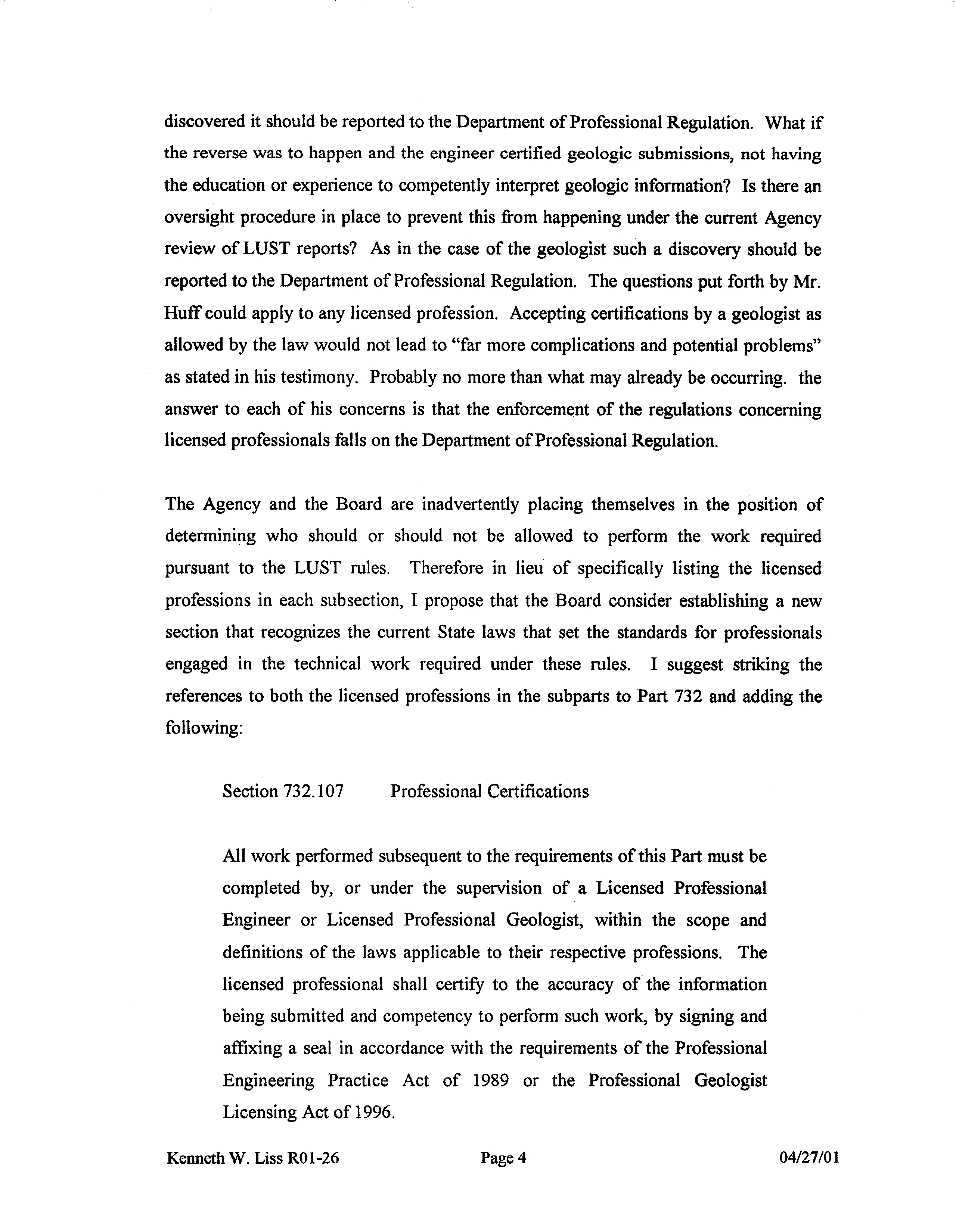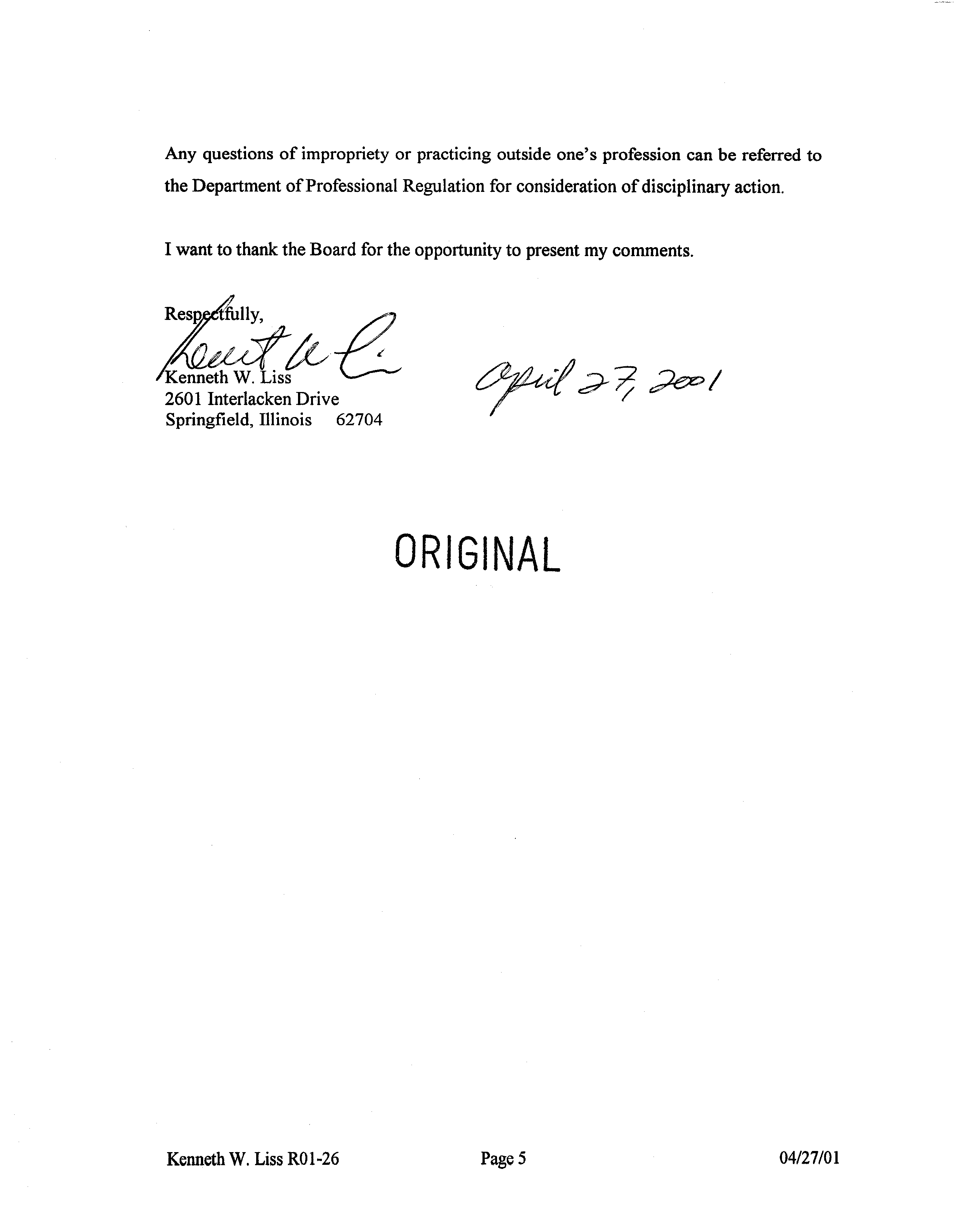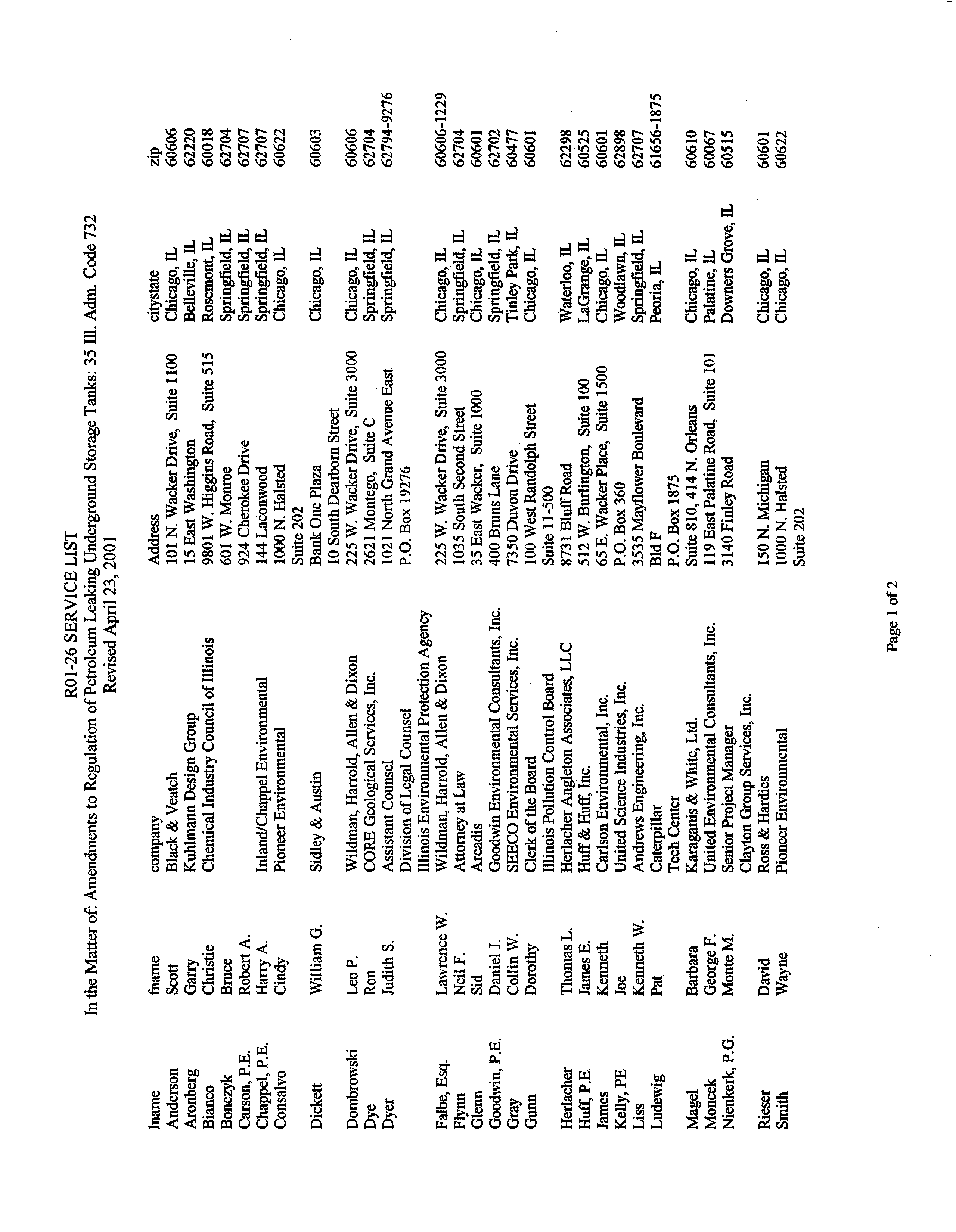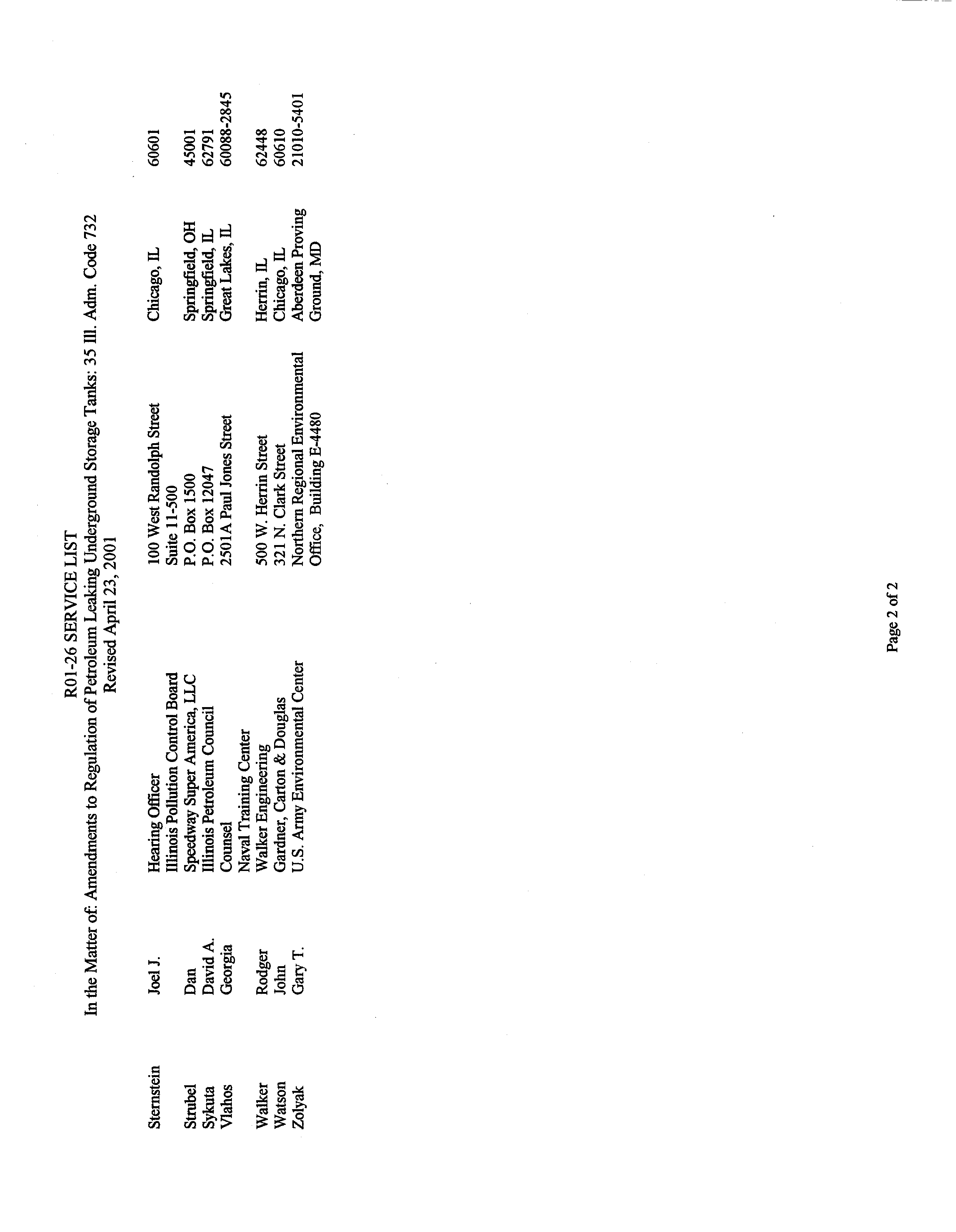R~c~xvEr~
CLERK’S O1’i’i~
APR
3
0
2Oo~
BEFORE THf~fLEI$~O1S POLLUTION CONTROL BOA,I~?ATE OF
ILLINOi
5
Control
Board
IN THE MATTER OF:
)
)
PROPOSED
AMENDMENTS TO
)
ROI-26
REGULATION OF PETROLEUM
)
(Rulemaking
-
Land)
LEAKiNGUNDERGROUND STORAGE
)
TANKS:
35
ILL. ADM. CODE 732
)
NOTICE OF FILING
TO:
Ms. Dorothy M. Gunn
Clerk ofthe Board
Illinois Pollution Control Board
James R.
Thompson Center
100 West Randolph Street
Suite 11-500
Chicago, Illinois
60601
(By Federal Express)
Mr. Joel J.
Sternstein
Hearing Officer
Illinois Pollution Control Board
James R.
Thompson Center
100 West Randolph Street
Suite 11-500
Chicago, Illinois
60601
(By Federal Express)
All persons listed on the attached service list by U.S.
Mail
Please take notice that today I have filed comments with the Illinois Pollution Control
Board in the matter entitled above.
Dated:
April 27,
2001
THIS FILING IS SUBMITTED ON RECYCLED PAPER
APR
3
0
~tj~j~
STATE OP ILUNOIS
BEFORE TIJIE ILLINOIS POLLUTION CONTROL BOAiw
Volluflon
Control Board
N
THE MATTER OF:
)
)
PROPOSED AMENDMENTS TO
)
RO1-26
REGULATION OF PETROLEUM
)
(Rulemaking
-
Land)
LEAKiNG UNDERGROUND STORAGE
)
TANKS: 35 ILL. ADM. CODE 732
)
TESTIMONY OF KENNETH
W. LISS
My name is Kenneth W.
Liss.
I am a geologist, licensed by the Illinois Department of
Professional Regulation.
I am submitting my
comments to those filed by the ISPE and
the CECI.
I am unable to attend the hearings and
ask that you accept my
comments
into the record.
For several years I worked on various drafts
and testified in
favor ofthe bill that
ultimately became the Professional Geologists Licensing Act (Geologists Act).
I was
appointed to the first Board ofLicensing (Board) under the
Act.
During my tenure on
the Board, we formulated the rules required forthe administration ofthe Act,
including
the recommendations and
opinions regarding the qualifications of applicants for
licensing.
For over
14 years I worked at the Illinois Environmental Protection Agency
as a geologist,
approximately eight ofthose years as manager ofthe Groundwater Unit,
Permit Section, Bureau ofLand.
Concerning the submissions
ofMr.
Bonozyk,
attorney for the ISPE
and
the
CECI, I
have the following comments:
The General Assembly did not
purposely
exclude the references to the Professional
Geologist Licensing Act when amending the
LUST
legislation. Actually
it was the
influence of the CECI and
the ISPE in
the drafting ofthe legislation with the Agency.
Although as a group of professionals,
we were eventually
successful
in
getting the
licensing Act passed,
the different
groups of geologists involved
in that effort
did not
have the
organizational
structure
or
resources to
continue.
The
Agency
took
the
position not include references to the Professional Geologist Licensing
Act in
KennethW.
Liss RO1-26
Page
1
04/27/01
subsequent legislative or rulemaking actions under the
premise that the Professional
Geologist Licensing Act was only recently passed, not effective until
July
1,
1996
and
would
require rulemaking and a grandfathering period before
licensed professionals
would be available.
This position was taken despite objections from geologists within
the Agency.
The intent ofthe General Assembly and the importance they placed on the practice of
geology is clearly stated in
Section 5(a)
through (h) and
Section
10 ofthe Professional
Geologist Licensing
Act.
The Act
is
an accurate representation of the intent of the
General Assembly as compared to the presumptions presented by Mr. Bonczyk for the
ISPE and
CECI. Section 5(a) and
Section
10 are as follows:
Sec.
5.
Findings.
The General Assembly finds that:
(a)
In recent years, governmental bodies have increasingly come to
rely upon
advice from geologists when formulating laws and policies to
protect the environment and the safety, property, and well-being of the
citizens ofthis State.
Sec.
10. Declaration of public policy.
The practice ofprofessional
geology in the
State ofIllinois
is hereby declared to
affect the public
health, safety, and well-being ofits citizens
and
to be subject to
regulation
and
control in the public interest.
It is further declared
that the practice ofprofessional geology,
as defined
in
this Act,
merits
the confidence
of the public, and that only qualified persons
shall be authorized to engage in the practice ofprofessional geology
in the State ofIllinois.
This Act shall be liberally
construed
to
best
carry out this purpose.
(emphasis applied)
The references to Licensed Professional Engineer (engineer) found in Section 57 ofthe
Environmental Protection
Act
are
broad
enough
in
scope to allow Licensed
Professional Geologists (geologist) to
perform work under the Part 732 (LUST) rules.
The
references
to
Licensed Professional
Engineer found
in
Section
57
require
an
engineer to
certify
certain submissions to the Agency,
but indicates the work
can be
performed under the direction ofthe engineer, not specifically by the engineer..
Now looking at the LUST rules without the proposed amendments, the term Licensed
Professional Engineer
is
included
in
nearly every section and
often subsection
of the
technical
portions
of
the
existing
rules.
The reference to Licensed Professional
Kenneth W. Liss
RO1-26
Page 2
04/27/01
Engineer
is
not
only
applied beyond
the requirements
of Section
57,
but
also
in a
manner that requires or implies that the engineer perform the work as opposed to
only
directing the work. One
exception
is
noted in
Section 732.312
Classification
by
Exposure Pathway Exclusion (d) where it includes
“.
.
.
(or, where appropriate, persons
working under the direction of a Licensed Professional Engineer)...”.
Ifthe comments
of the
ISPE
and
CECI are
correct
in
challenging the
Board’s authority to
include
Licensed Professional Geologist in
the rules,
it appears that many of the references to
Licensed Professional Engineer
in
the existing rule also go beyond the
authority of
Section
57 ofthe Environmental Protection Act.
ConcerningMr. HutVs comments
and questions:
In the first
paragraph on
page
3
of his
testimony,
he
states that “Geologists are not
trained as design professionals though they provide valuable scientific services”.
In the
context ofthe definition ofLicensed Professional Engineer, I agree with this statement.
However within the definition of the practice of professional geology, a geologist
is
a
design
professional.
Geology
is
a
science.
For
instance,
studies in
the science
of
geology, including
soils,
fluids,
rock
and
earth processes educate us in the areas
of
stratigraphy and
lithology.
With that
knowledge, a geologist
is able to make efficient
and
intelligent interpretations concerning migration pathways beyond simply plugging
parameter values into formulae.
A geologist
will design a subsurface investigation
to
fulfill the requirements of a corrective action
plan
and
determine appropriate actions.
This may include the
design of a slurry wall or a groundwater injection or extraction
program.
While
there
is
a distinction between the
potential
designs
of
the
two
professions, the term design professional is not exclusive to engineering.
In
the second paragraph
on
page
3,
several
questions are raised concerning the
ramifications ofallowing Licensed Professional Geologists to practice under the LUST
rules.
The first question concerns the potential
consequences of the Agency accepting
a geologist’scertification that entails engineering.
Ifsuch a submission
is
Kenneth W.
Liss RO1-26
Page 3
04/27/01
discovered it should be reported to the Department ofProfessional Regulation.
What if
the reverse was to happen and
the engineer certified geologic submissions, not having
the education or experience to competently interpret geologic information?
Is there an
oversight procedure in
place to prevent this
from happening under the current Agency
review of LUST
reports?
As
in
the case of the geologist such a discovery should
be
reported to the Department ofProfessional
Regulation. The questions
put forth by Mr.
Huff could apply to any licensed
profession.
Accepting certifications by a geologist as
allowed by the law would
not lead to “far more complications
and
potential problems”
as stated in
his testimony.
Probably no
more than what may already be occurring, the
answer to each of his
concerns
is
that the enforcement of the regulations
concerning
licensed professionals falls on the Department ofProfessional Regulation.
The Agency and the Board are inadvertently
placing themselves in
the position
of
determining
who
should
or
should
not be allowed to perform the work required
pursuant to the LUST
rules.
Therefore
in
lieu
of specifically
listing
the
licensed
professions
in
each
subsection,
I propose that the Board consider establishing a new
section that
recognizes
the current
State
laws that
set
the
standards
for professionals
engaged
in
the technical work required under these
rules.
I
suggest
striking the
references to both the licensed
professions
in
the subparts to Part 732 and
adding the
following:
Section 732.107
Professional
Certifications
All work performed subsequent to the requirements ofthis Part must be
completed
by,
or
under the
supervision
of a Licensed Professional
Engineer
or
Licensed Professional
Geologist, within the scope
and
definitions
of the laws
applicable
to their respective professions. The
licensed professional
shall
certify to
the accuracy
of the
information
being submitted
and
competency to perform
such work, by signing
and
affixing a
seal
in
accordance with the requirements of the Professional
Engineering
Practice
Act
of
1989
or
the
Professional
Geologist
Licensing Act of 1996.
Kenneth W. Liss RO1-26 Page
4
04/27/0 1
Any questions of impropriety or practicing outside one’sprofession can be referred to
the Department ofProfessional Regulation for consideration ofdisciplinary action.
I want to thank theBoard forthe opportunity to present my comments.
Resp tfully,
Kenneth W. Liss
2601
Interlacken Drive
Springfield, Illinois 62704
ORIGINAL
Kenneth W. Liss RO1-26 Page
5
04/27/01
0
r~l
-000
c~4
N
\O ~O ‘~O
~D ~.O~O \O
0~
c’~
\O~~
0
00o’~
0
0e~
~ ~3\O\O
0’~
oooor-o
0
e~I 0
~4 00
00
00 ‘I~ -400
L~
\O
~
0
C~
(~~I
—
Q
~~G)
—
0
~
~
OGJ~
~
I-
~ ~‘JC~
4::
•~ri2u2I~i2Q
Qr,~Ury~E—U
~
0
(.~
UC~)
0
0
0
0
—
I,~
0
~
0
0
—
—
0
~
Li-I
o
0~
~
4-
i-~
~
~UG)~
0J’~
~.)
—
o
Zncu
~
O~~
0)Q4-
~
~ 0)
on
~U
0
~
~
•.~
0
U2
0
0
o
r
0)
~L)
—
~
.~
4-
U
~
0)
~ ~Ou~
~
2
u~~OUm~•~
~
0
~
C.)
—u~
ii
I
0
0
.~
0
0 0
>
~
—
0
.~
U
6
~
~
0~rJ~
0.)
-~
o
_
-~
n
~
m(.~
Li
(5
I-
0~-
0
Li-I
~
_
U
~
04
~ ~0) ~
_
.~
~
0E:—mr~
~C0mt~
000
0e’~
00
lr~
0
-o
I-
n
o
0
0.)
0
4-
0.)
0.)
0
-4
0.)
0
0)
0)
-4
0
00
N
mr~
I
I
-400
00
0
0
0
0
0’~ 00
~
—
—
~O
0~-0
~O0
0
‘r~ N
0
N
0—
~
eN
m
0
nn
4-
Q
ri2t~
.)~Q
0)
a
0)
.I~0
0)
~00
~
~j,
0)~
~
2
En
on
~
~
0)’00
—~
~
~oe~ZO
Q
(4-
0
N
0)
\0
0)0)
En
(.4
—
0)
4-
0
0)
o
00)
4-
n~o
~
—
~
~
~
0)0
j
~
~
0
I-
0)
~
H
~
U)
